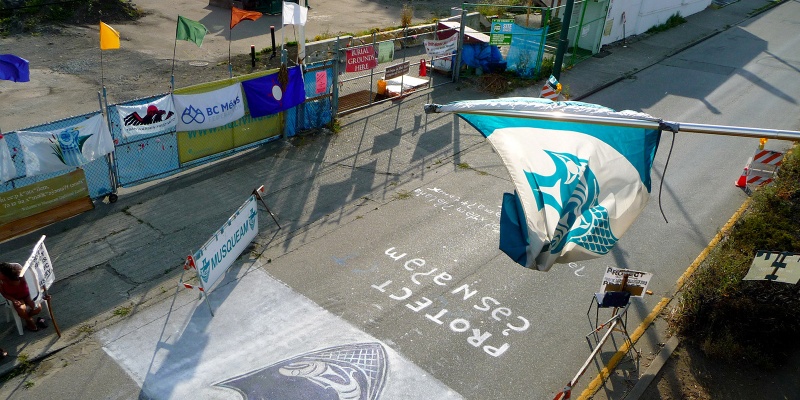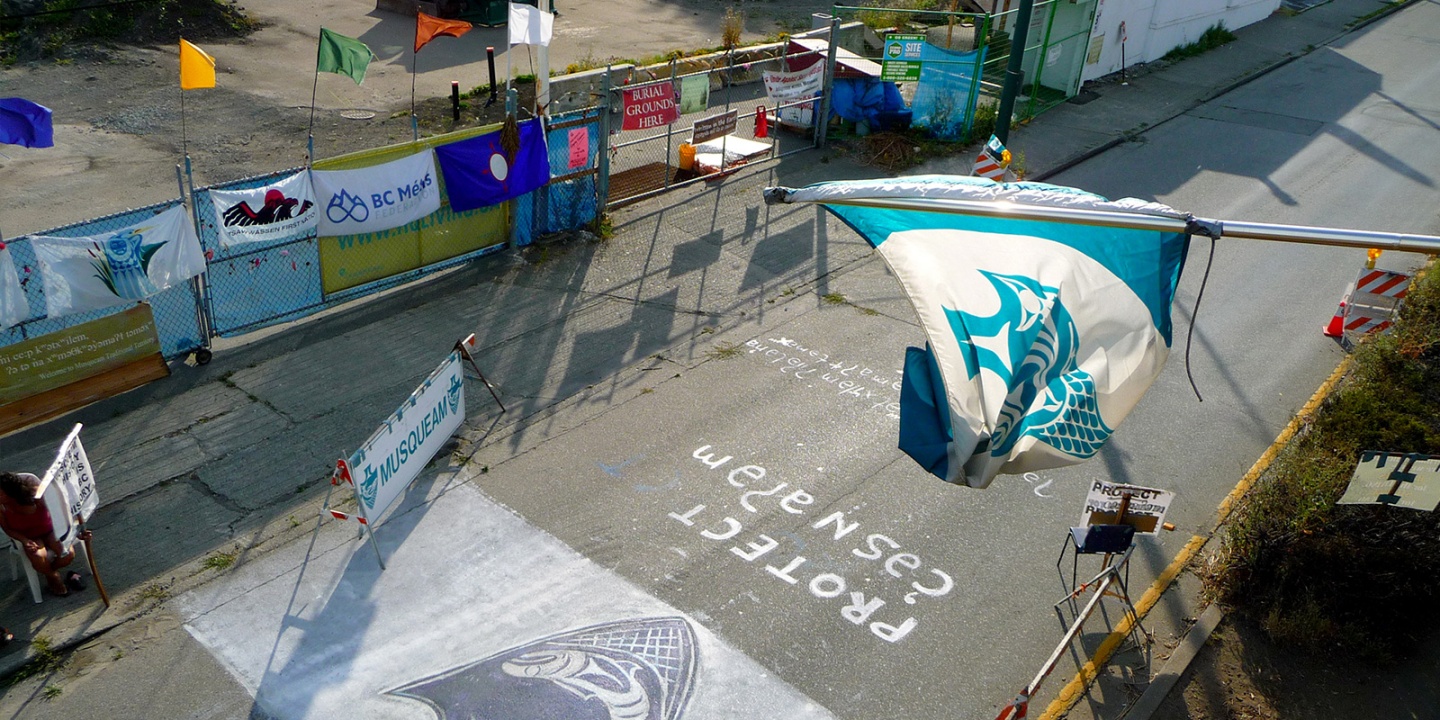An Interview with Elle-Máijá Tailfeathers
By Maya Sarin
This film is part of the annual #mustseeBC filmmaker showcase presented by STORYHIVE, now open until September 28th. Visit mustseebc.viff.org/ for more details and to vote for c̓əsnaʔəm: the city before the city.
Elle-Máijá Tailfeathers is a jack of all trades when it comes to the world of film. Not only does Tailfeathers have extensive experience in writing, producing and acting, but directing as well, having just directed her own feature-length documentary titled c̓əsnaʔəm: the city before the city. Tailfeathers studied acting at Vancouver Film School and received her bachelor’s degree in First Nations studies with a minor in women and gender studies from the University of British Columbia. Tailfeathers’ background consists of being Blackfoot from the Kainai First Nation, as well as Sami from Norway. c̓əsnaʔəm: the city before the city will be featured as part of VIFF’s SEA TO SKY program stream this year, which honours 12 unique BC filmmakers and their groundbreaking films. c̓əsnaʔəm: the city before the city looks at Vancouver before real estate, back when BC was still in its natural, untouched state. Tailfeathers has teamed up with the Musqueam First Nation and the UBC Museum of Anthropology curatorial team to create a moving, informative documentary about the history of the Lower Mainland and the Musqueam community, prior to urbanization.
Maya Sarin: What initially inspired you to direct a feature-length documentary on what originated as a 3-site museum exhibition between the Musqueam Indian Band, the UBC Museum of Anthropology, and the Museum of Vancouver?
Elle-Máijá Tailfeathers: I actually worked on the museum exhibition and was fortunate enough to get the opportunity to do all of the video work for the three-site exhibition. I felt really connected to the Musqueam Indian Band and was saddened to think that the footage would just disappear after the exhibitions ended, especially after interviewing over thirty community members. So, I pitched the idea of repurposing the footage into a documentary in order to preserve it as kind of a legacy project for the exhibition. I felt like it was important for people in this city to learn about Vancouver’s history and the Musqueam community itself. Their culture is still very much alive, which speaks to the strength of their community.
Sarin: I understand that you are a member of the Kainai First Nation yourself; did this play a part in choosing to c̓əsnaʔəm: the city before the city or in your overall vision for the film?
Tailfeathers: As an indigenous person, I often feel compelled to create films that reflect something of that subject matter, but each individual First Nation community is really unique, especially when it comes to language and culture. I learned so much from the Musqueam community and was grateful for the opportunity to learn more about this place that I’ve called home for the past 12 years.
Sarin: What role did your own past play in forming the concept of this movie?
Tailfeathers: Just living here for the past 12 years and going to UBC, where I studied First Nations and indigenous studies. I became aware of the Musqueam community while studying at UBC and always wanted to learn more. Over the last eight or nine years I have formed a relationship with people in the Musqueam community and I felt a certain responsibility to do something with that knowledge.

Sarin: Was creating a film focused on local history/events important to you or a decisive starting point?
Tailfeathers: Yes, because I would consider myself an urban indigenous person, so in many ways I feel like I’m part of the broader indigenous community. I also just like to work from where I’m from. I feel close to this story and honouring the Musqueam community. Aspects of this film talk about the damage museums, anthropology, archeology, and all social sciences, have done in desecrating sacred sites; people in Vancouver aren’t aware of the fact that village sites and burial sites have been excavated so many times and that so many ancestral remains have been moved to museums around the world. It’s easy for people to erase the history of this city, rather than confront what’s ugly. I really hope to continue this conversation on Vancouver’s history and how it hasn’t always been an amicable, pretty place.
Sarin: Can you briefly describe what the trajectory of creating this film looked like; how did the idea come to fruition? What key steps were there along the way in order to make it possible?
Tailfeathers: Like I said, I started by working on the three-site exhibition and doing all the video work for them. Just by sitting in the room filming the interviews, I was very moved; I laughed, I cried and just wanted to see the footage be preserved. I worked really hard on the exhibition, creating close to 140 minutes of video clips for the three sites and then the thought occurred to me to try and continue the spirit of the exhibition by putting the footage into a feature-length documentary. It has been a really long, slow process because it is an independent film with minimal funding and I have to consider what is important to the curatorial teams. I’ve had to cut 40 to 50 hours of interview footage down to 75 minutes. It has taken over a year to get to this point and I’ve done all the editing myself, but it has been a very humbling and enriching experience.
Sarin: Having worked in the film industry in other roles as well, such as acting and writing, how was directing a film like this a unique experience for you?
Tailfeathers: I don’t really feel any ownership to this project in a sense, which is liberating. I haven’t been thinking about it as much in an artistic sense, but more as a tool for sharing knowledge for the people in Vancouver and across BC. It was made for the Musqueam community and not as a career move for myself. With Canada having just celebrated its 150th anniversary, I want to show that its ancient history is still very much alive.
Sarin: What was your favourite part of creating this documentary? Was there a particular moment of clarity that stood out to you throughout the process?
Tailfeathers: Just learning from the community in general. It has been an incredible learning process for me as an individual; so much research has been done and I’ve really enjoyed that process and just getting really familiar with the subject matter. I guess I’m just kind of a nerd when it comes to research so I just really enjoyed that aspect.

Sarin: What do you ultimately hope your audience will get out of watching c̓əsnaʔəm: the city before the city? What will they learn or understand about Vancouver that they didn’t necessarily know or realize before?
Tailfeathers: So much. There’s historical sites all over the city and I hope that people begin to understand the ancient history of the Musqueam people who first settled here. I want people to begin to understand how urbanization of this place has affected indigenous land. For example, this year there was virtually no fishing on the Fraser River, directly correlating to our colonialization, overfishing and global warming. I want viewers to walk away with a better understanding of that and with stronger intentions of interrogating their presence with this land.
Sarin: Is there anything else you’d like to add?
Tailfeathers: I’m just really excited that this film is premiering at VIFF for a local audience. I was overjoyed when I heard that this is where it would be premiering.
c̓əsnaʔəm: the city before the city is premiering at the Vancouver International Film Festival as part of the SEA TO SKY program stream on Sunday, October 1 and showing again Friday, October 6. Tickets available here.
